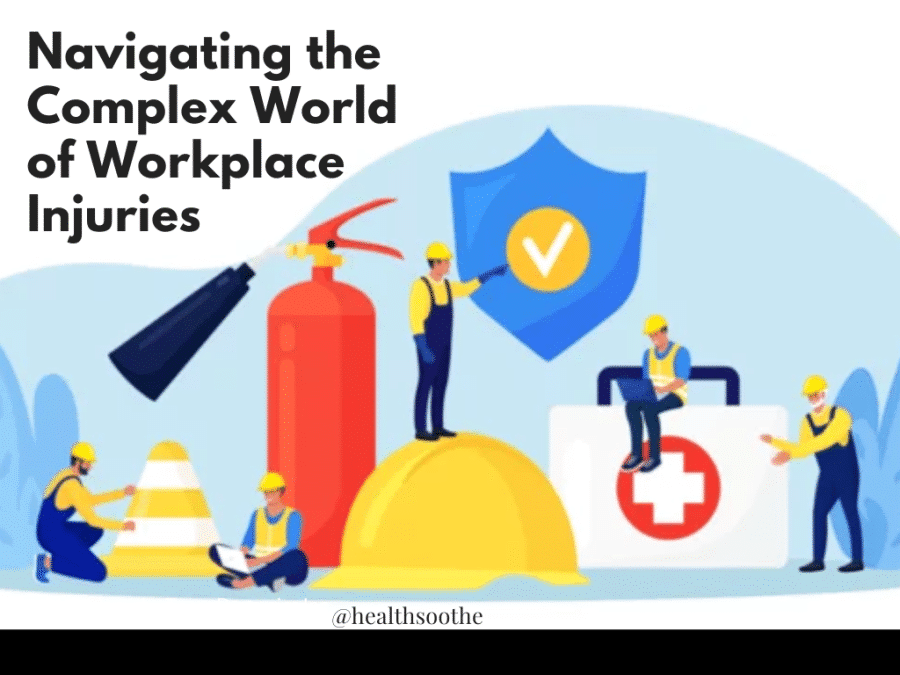Workplace injuries. They can strike when you least expect them. A moment’s lapse in attention or a simple misstep, and suddenly you’re caught in a whirlwind of paperwork, legal processes, and physical recovery. With the ever-evolving world of work, staying ahead of the game in workplace injury trends and developments is crucial for employees and employers alike. So, let’s dive in, shall we?
A New Era of Workplace Injuries
As the landscape of work shifts, so do the types of injuries we see. Gone are the days of solely factory floor mishaps and construction site accidents. Now, we’re dealing with a host of new challenges.
A Digital World: Ergonomic Injuries on the Rise
Hunching over laptops, smartphones, and tablets, we’re all guilty of it. But did you know that our digital dependency has led to an increase in ergonomic injuries? From carpal tunnel syndrome to chronic back pain, the physical effects of our digital lifestyle are real.
According to a well-known Brooklyn injury lawyers firm, “The number of ergonomic injuries in the U.S. is on the rise, and we expect this trend to continue.”
Preventing ergonomic injuries requires a proactive approach and ongoing commitment from employers. Leaders should set an example by practicing good ergonomic habits themselves. Moreover, they should address issues such as poorly positioned computer monitors, uncomfortable chairs, and improper keyboard and mouse placement.
Implementing standing desk options and organizing ergonomic workshops can help reinforce the importance of movement. Employers must consider using visual aids or reminders to encourage correct positioning.
Additionally, having a workers’ compensation chiropractor can bring numerous benefits to both employees and employers dealing with work-related injuries. A workers comp chiropractor performs spinal adjustments and various techniques, alleviating pain and promoting the body’s natural healing processes.
The Gig Economy: New Workers, New Risks
Ever heard of a rideshare driver or food delivery cyclist getting injured on the job? The gig economy has opened up a new realm of workplace injuries. And with gig workers often lacking traditional employee protections, navigating the legal system can be a minefield.
When a gig worker sustains an injury, they may face a legal gray area. Determining liability can be tricky, as gig economy platforms usually classify their workers as independent contractors, which can exempt these platforms from certain responsibilities, including workers’ compensation coverage and employee benefits.
Thus, gig workers might need to navigate insurance claims, liability disputes, and legal obstacles. Seeking compensation for hospital expenses, lost wages, and other damages becomes an uphill struggle. The lack of legal frameworks tailored to gig economy workers exacerbates the difficulty.
Without conventional employee protections, gig workers increasingly turn to advocacy groups, legal aid services, and unions for support. These organizations are pivotal in raising awareness about gig workers’ unique risks and advocating for their rights.
Mental Health: An Overlooked Aspect
Once brushed under the rug, mental health in the workplace is finally gaining recognition. Stress, burnout, and even workplace bullying can all lead to serious mental health issues. It’s time to address the elephant in the room, don’t you think?
The Legal Landscape: Know Your Rights
In the ever-changing world of workplace injuries, understanding your rights is essential. Here’s what you should know:
- Workers’ Compensation Laws: Designed to protect employees, these laws provide financial support for medical expenses and lost wages. Stay informed about the coverage and benefits available to you.
- Employer Responsibility: Employers have a legal obligation to maintain a safe work environment. This includes implementing safety measures, providing necessary training, and addressing potential hazards.
- Mental Health Protections: Mental health issues resulting from workplace stress or harassment are increasingly recognized as legitimate injuries. Know your rights when it comes to seeking support and compensation for mental health-related claims.
- Legal Representation: In the event of a workplace injury, you have the right to seek legal advice and representation. A qualified lawyer can help you navigate the complexities of workers’ compensation and ensure your rights are upheld.
Remember: staying informed empowers you to take control of your situation.
Prevention: Your Best Defense
They say an ounce of prevention is worth a pound of cure. So, what can you do to protect yourself?
- Stay ergonomically sound. Invest in a proper chair, use a standing desk, and take breaks to stretch and move.
- Know the risks. Understand the hazards associated with your specific line of work and take steps to mitigate them.
- Keep your mental health in check. Speak up if you’re struggling and seek support when needed.
Small steps can make a world of difference.
Navigating the Aftermath
Even with the best-laid plans, accidents can still happen. So, what should you do if you find yourself facing a workplace injury?
- Report it: Inform your employer immediately. Don’t let fear or embarrassment stop you – it’s your right to report an injury.
- Seek medical attention: Your health comes first. Get the care you need and keep records of all treatments and diagnoses.
- Document everything: Take photos, get witness statements, and maintain a detailed account of the incident and its aftermath.
- Know your rights: Familiarize yourself with workers’ compensation laws and your legal entitlements. When in doubt, consult an expert.
- Get help: Navigating the legal system can be daunting. Reach out to a professional, like a Brooklyn injury lawyer, for guidance and support.
Remember, you don’t have to face this alone.
Looking Ahead: The Future of Workplace Safety
As we continue to adapt to new work environments and emerging risks, the future of workplace safety remains uncertain. But there’s hope on the horizon. With advances in technology, greater awareness of mental health, and a collective commitment to creating safer workspaces, we can work together to reduce the impact of workplace injuries.
So, my friends, let’s stay informed, be proactive, and look out for one another. Together, we can navigate the complex world of workplace injuries and emerge stronger on the other side.
Effective Strategies for Bursitis Prevention and Treatment
Nothing can slow down your active life quite like bursitis. Those nagging aches and pains in your joints can be mildly annoying to off-the-charts painful. Just ask those suffering from this condition, and they’ll tell you that it’s something you definitely don’t want. Certain types of folks are more susceptible to this painful condition, but no one is truly immune. Fortunately, bursitis can be prevented. For those already suffering from it, there is treatment.
Naples area residents desperately seeking relief from the blasts of bursitis pain should contact the Bursitis treatment experts at NCIC. Don’t suffer; treatment and prevention suggestions are within your reach.
What Is Bursitis?
In a nutshell, bursitis is painful swelling around a joint. All joints are subject to developing this condition, but it’s more typical to affect knees, elbows, and shoulders. The body’s joints are surrounded by a small, fluid-filled sac called a bursa. Inflammation of the bursa is what we call bursitis. Our bones and joints are surrounded by bursa, which acts as a cushion of protection. However, once overworked, it can cause some problems.
When a bursa is overused, it becomes swollen and irritated. Once inflamed, the entire surrounding area can become painful, which is especially obvious around a joint. Normal range of motion can become limited, and movement can be quite painful. The cause of bursitis is usually overuse of a joint or putting far too much pressure on it.
Symptoms and Most Common Causes of Bursitis
The symptoms of bursitis are easily recognized. Sufferers typically feel pain when moving the affected part with a limited range of motion. For example, someone suffering from bursitis of the elbow, known as olecranon bursitis, will experience pain radiating from the affected elbow and can also have difficulty fully extending and retracting the arm.
Most bursitis sufferers have this condition due to overusing a certain joint or extremity. Anyone employed in a job that requires long hours of repetitive motion is at risk of developing this condition. House painters and carpenters are highly vulnerable to bursitis due to the nature of their work. Athletes, such as baseball players and golfers, often develop bursitis. This can affect professionals and also novices.
Bursitis Prevention
For those with a history of daily repetitive movements, either as a part of your job (painters, carpenters) or as a part of your hobby (sports enthusiasts, musicians), the best thing you can do to prevent bursitis is to take frequent breaks. Avoiding the repetitive movement that could help to develop or aggravate bursitis may or may not be possible and will depend on your career or how much time you devote to your hobby. However, taking adequate breaks is key to preventing bursitis.
Other effective means to the prevention of bursitis include:
- Maintaining a healthy body weight
- Frequent exercise to keep your body strong
- Using protective equipment like kneeling pads to protect joints
- Learn the proper techniques to lift heavy objects
- Maintain good posture at all times
Bursitis Treatment
For the occasional bursitis flare-up, several home remedies could ease the pain and swelling associated with this painful and limiting condition. Popular home remedies include:
- Resting the affected joint
- Apply ice for the first 48 hours to help reduce swelling
- After 48 hours, switch to dry heat, such as a heating pad
- Over-the-counter medications like ibuprofen or naproxen sodium can help to relieve pain and inflammation
For more severe or chronic issues, chiropractic care can greatly help sufferers of all types of bursitis. After an evaluation of your condition, a licensed chiropractor can recommend treatments that can help relieve pain and inflammation but can also help to prevent bursitis from returning.
- Chiropractic adjustments – A chiropractor can help to restore a joint’s alignment, which will help to reduce pain and inflammation while helping to restore a full range of motion
- Physical therapy – Physical therapy can help to improve flexibility around the affected joint while increasing muscle strength
- Pain management – A chiropractor can determine the best non-invasive strategies for easing the pain of bursitis
Strategies for Bursitis Prevention and Treatment: Final Thoughts
Bursitis can be a painful condition. Unfortunately, the more you continue to use the affected body part, the more trouble it will cause you. However, by following some rules and making lifestyle changes, you can help prevent bursitis from affecting your job, hobby, and life in general.
Rest is key to prevention and also for treatment. When rest, ice, heat, and over-the-counter medications no longer provide relief, chiropractic care, and pain management can help reduce inflammation and lessen or eliminate the pain that comes with this condition. Chiropractic adjustments and physical therapy could be just what you need to get you back on track and pain-free.





